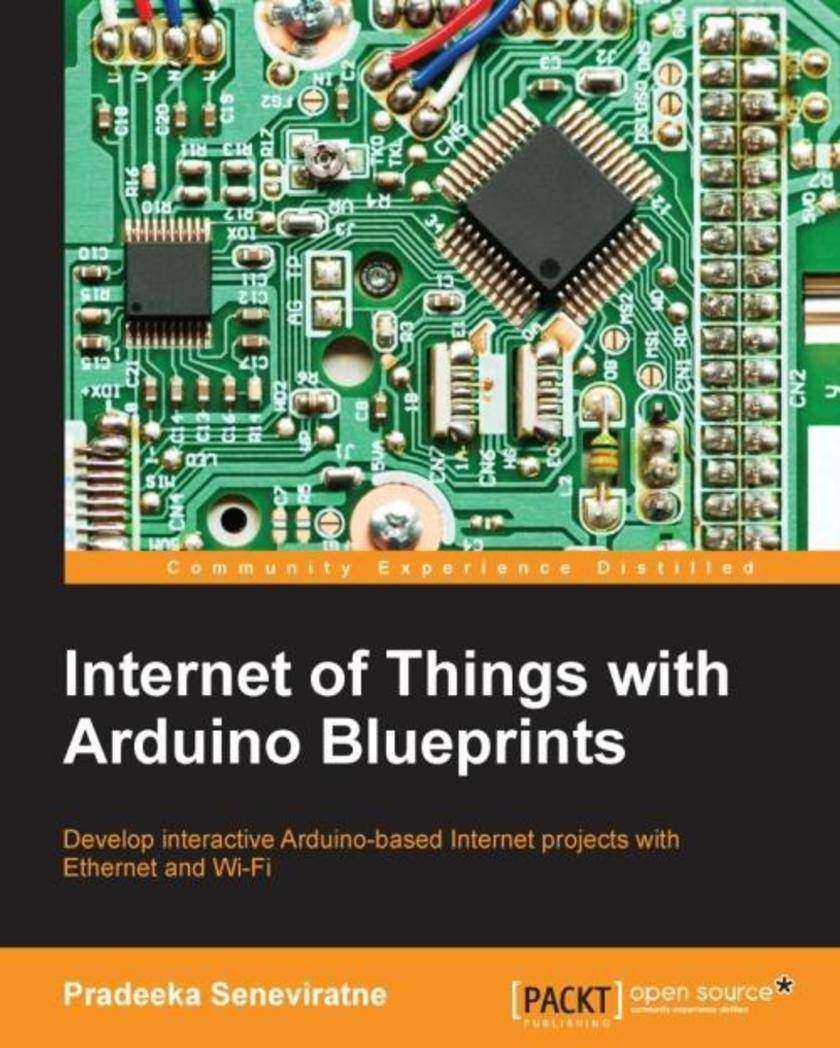
Internet of Things with Arduino Blueprints
¥71.93
Develop interactive Arduino-based Internet projects with Ethernet and WiFiAbout This BookBuild Internet-based Arduino devices to make your home feel more secureLearn how to connect various sensors and actuators to the Arduino and access data from InternetA project-based guide filled with schematics and wiring diagrams to help you build projects incrementally Who This Book Is For This book is intended for those who want to learn more about Arduino and make Internet-based interactive projects with Arduino. If you are an experienced software developer who understands the basics of electronics, then you can quickly learn how to build the Arduino projects explained in this book.What You Will LearnMake a powerful Internet controlled relay with an embedded web server to monitor and control your home electrical appliancesBuild a portable Wi-Fi signal strength sensor to give haptic feedback about signal strength to the userMeasure water flow speed and volume with liquid flow sensors and record real-time readingsSecure your home with motion-activated Arduino security cameras and upload images to the cloudImplement real-time data logging of a solar panel voltage with Arduino cloud connectorsTrack locations with GPS and upload location data to the cloudControl a garage door light with your Twitter feedControl infrared enabled devices with IR remote and Arduino In Detail Arduino is a small single-chip computer board that can be used for a wide variety of creative hardware projects. The hardware consists of a simple microcontroller, board, and chipset. It comes with a Java-based IDE to allow creators to program the board. Arduino is the ideal open hardware platform for experimenting with the world of the Internet of Things. This credit card sized Arduino board can be used via the Internet to make more useful and interactive Internet of things projects. Internet of Things with Arduino Blueprints is a project-based book that begins with projects based on IoT and cloud computing concepts. This book covers up to eight projects that will allow devices to communicate with each other, access information over the Internet, store and retrieve data, and interact with users—creating smart, pervasive, and always-connected environments. It explains how wired and wireless Internet connections can be used with projects and the use of various sensors and actuators. The main aim of this book is to teach you how Arduino can be used for Internet-related projects so that users are able to control actuators, gather data from various kinds of sensors, and send and receive data wirelessly across HTTP and TCP protocols. Finally, you can use these projects as blueprints for many other IoT projects and put them to good use. By the end of the book, you will be an expert in the use of IoT with Arduino to develop a set of projects that can relate very well to IoT applications in the real world.Style and approach Every chapter in this book clearly explains how to assemble components through easy-to-follow steps on while laying out important concepts, code snippets, and expected output results so that you can easily end up with a successful project where you can also enhance or modify the project according to your requirements.
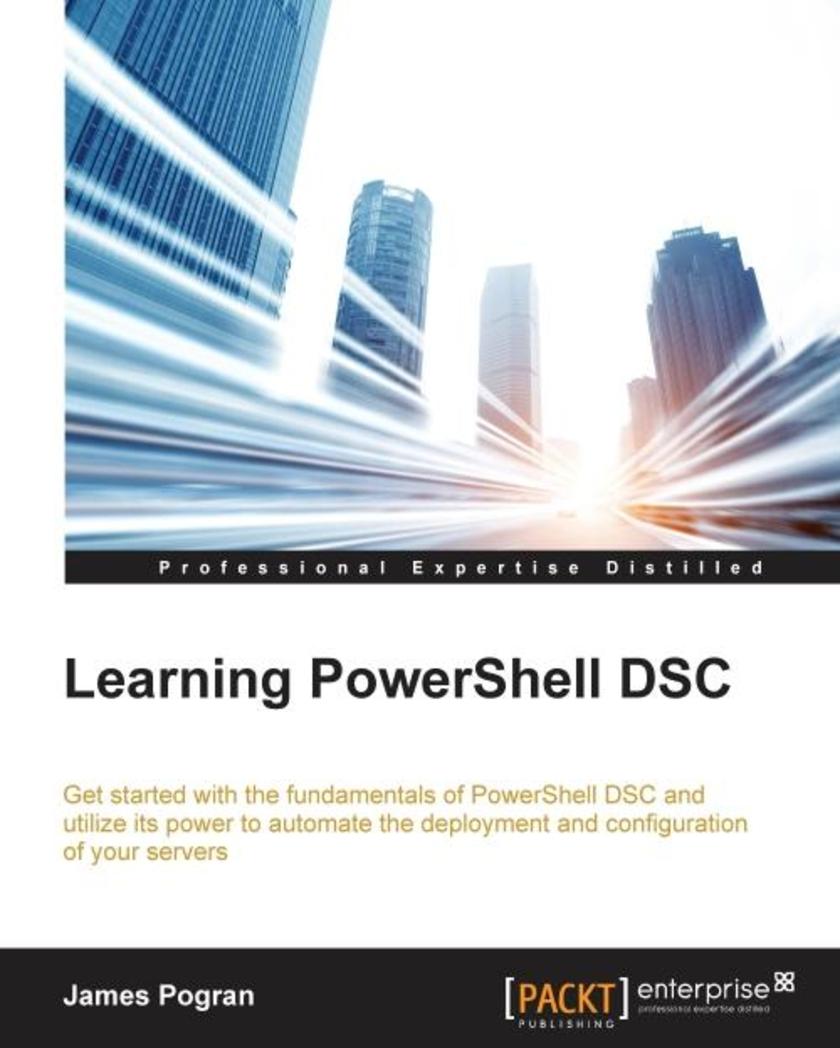
Learning PowerShell DSC
¥90.46
Get started with the fundamentals of PowerShell DSC and utilize its power to automate deployment and configuration of your serversAbout This BookCreate flexible and maintainable deployments using DSC configuration *s that stand the test of timeExplore the in depth details of the core architecture, concepts, and practices used by PowerShell DSCA step-by-step guide that shows you how to start using and taking advantage of PowerShell DSC Who This Book Is For This book is intended for system administrators, developers, or engineers who are responsible for configuration management and automation and wish to learn PowerShell Desired State Configuration for efficient management, configuration and deployment of systems and applications.What You Will LearnUnderstand configuration management and why you need itCraft flexible, reusable, and maintainable configuration *s for thousands of serversCreate custom DSC resources to manage any application or server settingApply configuration data to deploy applications to different environmentsUtilize DSC push deployments to test your configuration *s and custom DSC resourcesInstall, configure and use DSC pull serversRun a Windows MSI packageDeploy a website In Detail Windows PowerShell is a task-based command-line shell and *ing language designed especially for system administration. PowerShell DSC is a new management platform that enables you to deploy and manage configuration data for software services and manage the environment in which these services run. This book begins with an overview of the basics of PowerShell DSC by covering the architecture and components of the Desired Sate Configuration. It will then familiarize you with the set of PowerShell language extensions and new PowerShell commands. It will help you understand and create DSC configurations with the help of practical examples, and to create DSC custom resources for your custom applications. Finally, you will learn to deploy a real world application using PowerShell DSC. By the end of the book, you will have better knowledge about the powerful Desired State Configuration platform, which helps you to achieve continuous delivery, and efficient management and easy deployment of data for systems.Style and approach This book is an in-depth guide to using PowerShell DSC, full of real-world experiences and best practices using PowerShell DSC. The topics are explained and build on one another other to provide a holistic learning experience. At the end, all the features learned will be used to create a real world application deployment using DSC.
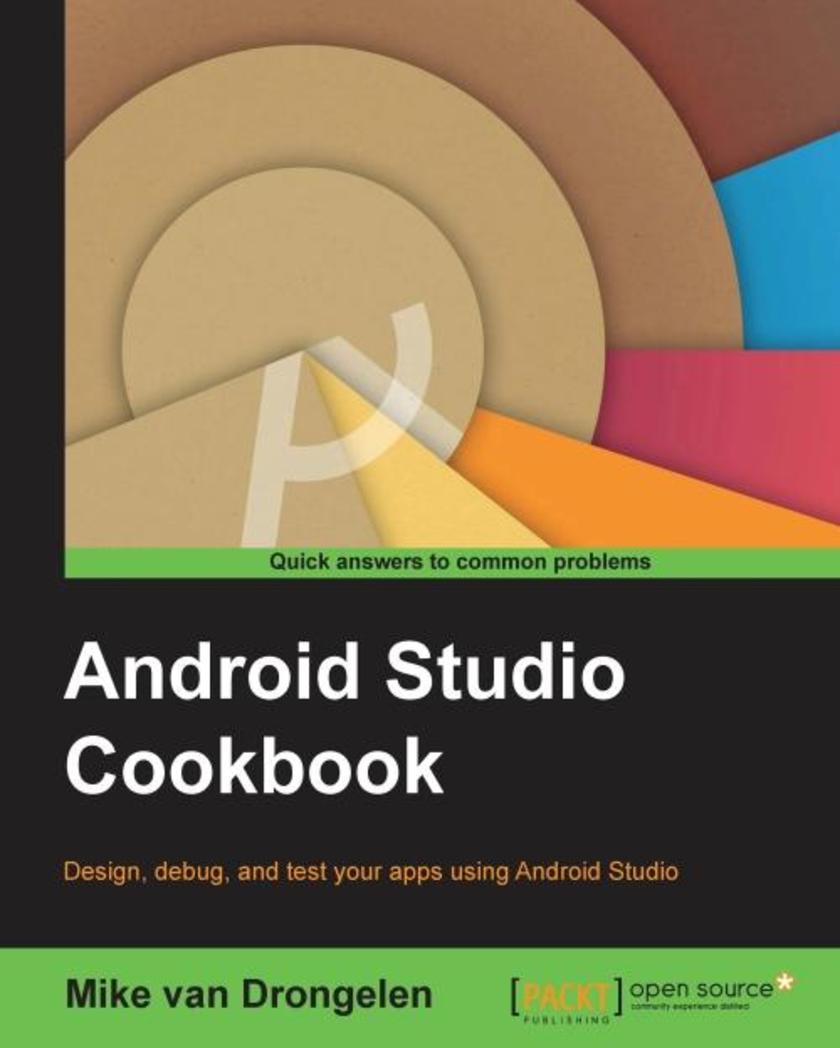
Android Studio Cookbook
¥71.93
Design, test, and debug your apps using Android StudioAbout This BookSee what Material design is about and how to apply it your appsExplore the possibilities to develop apps that works on any type of deviceA step-by-step practical guide that will help you build improved applications, change their look, and debug them Who This Book Is For This book is for developers that are already familiar with programming concepts and have already started creating apps for the Android platform, for example, by using the Eclipse IDE. It is for developers who intend to use Android Studio as their primary IDE or want to use Android Studio more efficiently.What You Will LearnDevelop Android Studio applications using GenymotionApply the concepts of Material design to your applicationsUse memory monitoring tools to tweak performanceBuild applications for Android WearableCapture images, video, or audio within your Android appUse content providers to display dataBuild apps with a cloud-based backendCreate media-related apps that will run on phones, phablets, tablets, and TVs In Detail This book starts with an introduction of Android Studio and why you should use this IDE rather than Eclipse. Moving ahead, it teaches you to build a simple app that requires no backend setup but uses Google Cloud or Parse instead. After that, you will learn how to create an Android app that can send and receive text and images using Google Cloud or Parse as a backend. It explains the concepts of Material design and how to apply them to an Android app. Also, it shows you how to build an app that runs on an Android wear device. Later, it explains how to build an app that takes advantage of the latest Android SDK while still supporting older Android versions. It also demonstrates how the performance of an app can be improved and how memory management tools that come with the Android Studio IDE can help you achieve this. By the end of the book, you will be able to develop high quality apps with a minimum amount of effort using the Android Studio IDE.Style and approach This is a practical guide full of challenges and many real-world examples that demonstrate interesting development concepts. Besides smartphones and tablets, it also covers Android wearable devices and Android TV. Although strongly recommended, it is not necessary to own any Android device yourself.
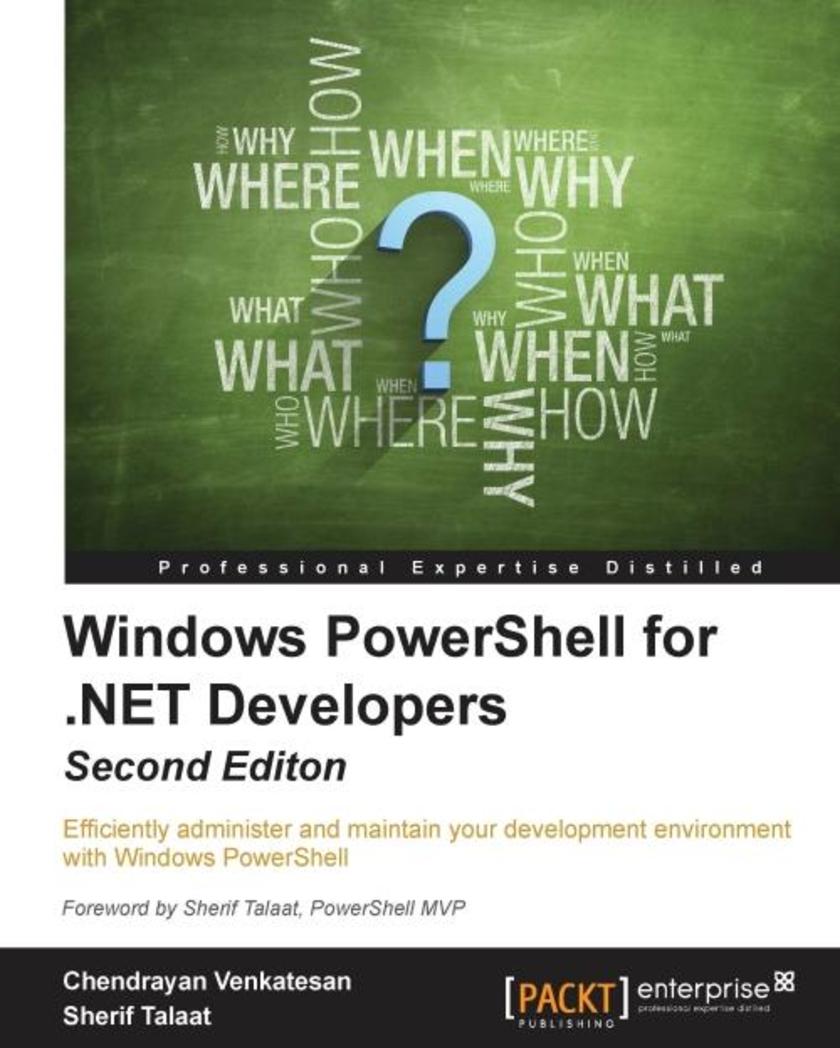
Windows PowerShell for .NET Developers - Second Edition
¥90.46
Efficiently administer and maintain your development environment with Windows PowerShellAbout This BookExplore *ing and automation techniques with Windows PowerShellGain concrete knowledge of Windows PowerShell *ing to perform professional level *ingDiscover the benefits of the Configuration Management Platform with this step-by-step guide that includes real-world *ing examples Who This Book Is For If you are an IT professional or developer who has worked on the .Net platform and you want to learn automation using Windows PowerShell, then this book is for you. This self-start guide takes you from the basics and gradually moves to an intermediate level to show you how to perform professional *ing.What You Will LearnUnderstand the concepts of building PowerShell *s and the basics of programmingManage the LYNC, Exchange, and SharePoint platformsCreate a Pull server using a SMB file share and HTTP and HTTPSUse .NET classes in Windows PowerShell and C# to manage Exchange OnlineUse PowerShell in C# to manage Exchange Online and work with .NET classes in PowerShellAutomate LYNC clients, consuming Client Server Object Models to administrate SharePoint Online In Detail Windows PowerShell 5.0 for .NET Developers is your self-start guide to performing automation using Windows PowerShell. This book will help you to understand the PowerShell syntax and grammar and will also teach you techniques to remove the rough edges of manual deployments. Packed with PowerShell *s and sample C# codes to automate tasks, it also includes real-world scenarios such as administrating office servers to help you save time and perform deployments swiftly and efficiently. The book begins with the Windows PowerShell basics, explores the significant features of Windows Management Framework 5.0, covers the basic concepts of Desired State Configuration and the importance of idempotent deployments. By the end of the book, you will have a good understanding of Windows PowerShell’s features and will be able to automate your tasks and manage configuration effectively.Style and approach This is an easy-to-follow step-by-step guide with text-enabled screenshots. Each topic is explained with codes and examples. It also includes multiple approaches for a number of tasks to let you choose the best one for you depending on your scenario.
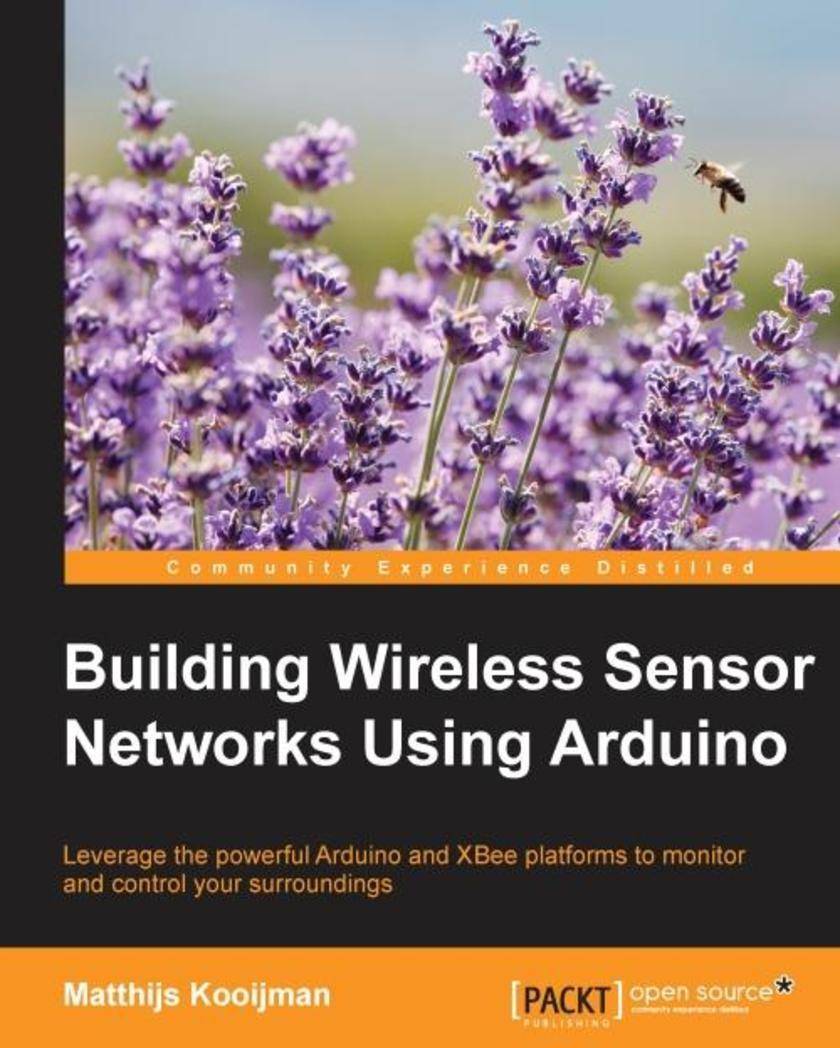
Building Wireless Sensor Networks Using Arduino
¥71.93
Leverage the powerful Arduino and XBee platforms to monitor and control your surroundingsAbout This BookBuild your own low-power, wireless network using ready-made Arduino and XBee hardwareCreate a complex project using the Arduino prototyping platformA guide that explains the concepts and builds upon them with the help of examples to form projects Who This Book Is For This book is targeted at embedded system developers and hobbyists who have some working knowledge of Arduino and who wish to extend their projects using wireless connectivity.What You Will LearnInteract with XBee boards using the XCTU program on Windows, OS X, or LinuxMake your Arduino boards communicate wirelessly, using XBee modules in the advanced API modeCentrally collect and store measured sensor data, in the cloud or your own databaseConnect the coordinator Arduino to the Internet and send data to web servicesControl your environment automatically, based on sensor input from your networkInteract with off-the-shelf ZigBee Home Automation devicesMake your devices battery-powered and let them sleep to get months or even years of battery life In Detail Arduino has been established as the de facto standard microcontroller programming platform, being used for one-off do-it-yourself projects as well as prototypes for actual products. By providing a myriad of libraries, the Arduino community has made it very easy to interact with pretty much any piece of hardware out there. XBee offers a great range of low-power wireless solutions that are easy to work with, by taking all of the complexity of wireless (mesh) networking out of your hands and letting you focus on what to send without worrying about the how. Building wireless sensor networks is cost-effective as well as efficient as it will be done with Arduino support. The book starts with a brief introduction to various wireless protocols, concepts, and the XBee hardware that enables their use. Then the book expands to explain the Arduino boards to you, letting them read and send sensor data, collect that data centrally, and then even control your home from the Internet. Moving further more advanced topics such as interacting through the standard Zigbee Home Automation protocol, or making your application power-efficient are covered. By the end of the book, you will have all the tools needed to build complete, real-world solutions.Style and approach A hands-on guide, featuring a single home automation project that can be built as described or with endless variations. Every step is illustrated with complete examples and screenshots, allowing you to build the examples swiftly.
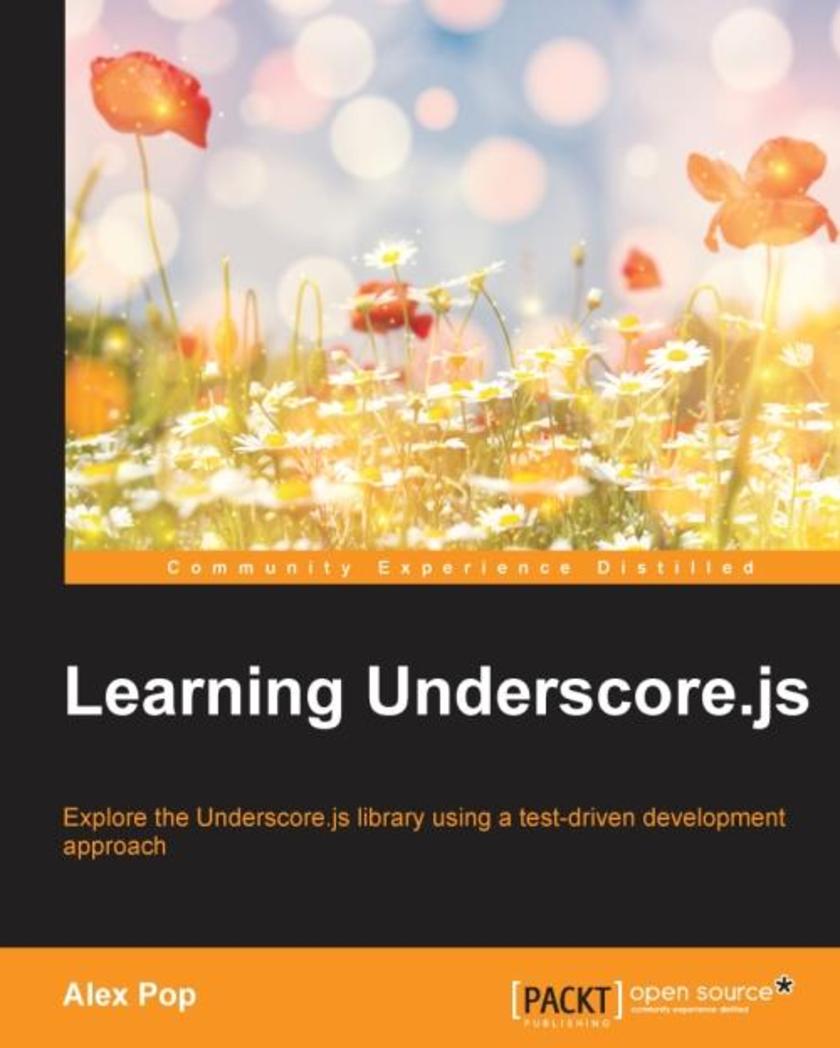
Learning Underscore.js
¥71.93
Explore the Underscore.js library by example using a test-driven development approachAbout This BookUnderstand and learn to apply functional programming principles using the built-in functions of Underscore.jsLeverage and reuse Underscore.js-based code to create code that targets client, server, or database contextsTake Underscore.js further by reusing code between client and server and by learning about other closely related libraries Who This Book Is For If you are a developer with fundamental JavaScript knowledge and want to use modern JavaScript libraries to extend your functional programming skills, then Underscore.js is an important library you should be familiar with.What You Will LearnReference and call Underscore.js functions using a modern JavaScript development workflowApply Underscore.js to JavaScript arrays, objects, and functionsTake advantage of object-oriented or functional programming techniques with Underscore.jsLeverage Underscore.js to create code that targets client, server, or database contextsExtend Underscore.js functionality with other closely related librariesReuse Underscore.js-based code between client and server applicationsPrepare for the upcoming JavaScript standard ECMAScript 6 and support older browsers In Detail Underscore.js is one of the most popular modern JavaScript libraries used for functional programming. It can be used as a base for building complex JavaScript applications in a sustainable manner and for building other JavaScript libraries. It embraces functional programming principles but is not opinionated and can be used with imperative, object-oriented, functional, or other programming styles. This book explores how to use Underscore.js to power your code and understand modern JavaScript development concepts while applying a lightweight and efficient workflow to build applications. The book starts with an incremental Underscore.js introduction by exploring key JavaScript concepts. You will then explore the basic features of Underscore.js in action and establish a lightweight development workflow that allows the provided examples to be guided by tests. The book then covers the functionality of Underscore.js with in-depth examples and explanations for understanding and applying the Underscore.js API. You'll also learn how to use Underscore.js as a base for your own modules and libraries within an object-oriented or functional programming style, and will be able to explore Underscore.js use cases in different environments. Eventually, you'll learn about libraries that are closely related with Underscore.js, how to share code between client and server, and how to prepare for the upcoming JavaScript standard ECMAScript 6.Style and approach This book takes an example-driven approach to describing some of the essential JavaScript concepts and practices that are useful for building sustainable applications.
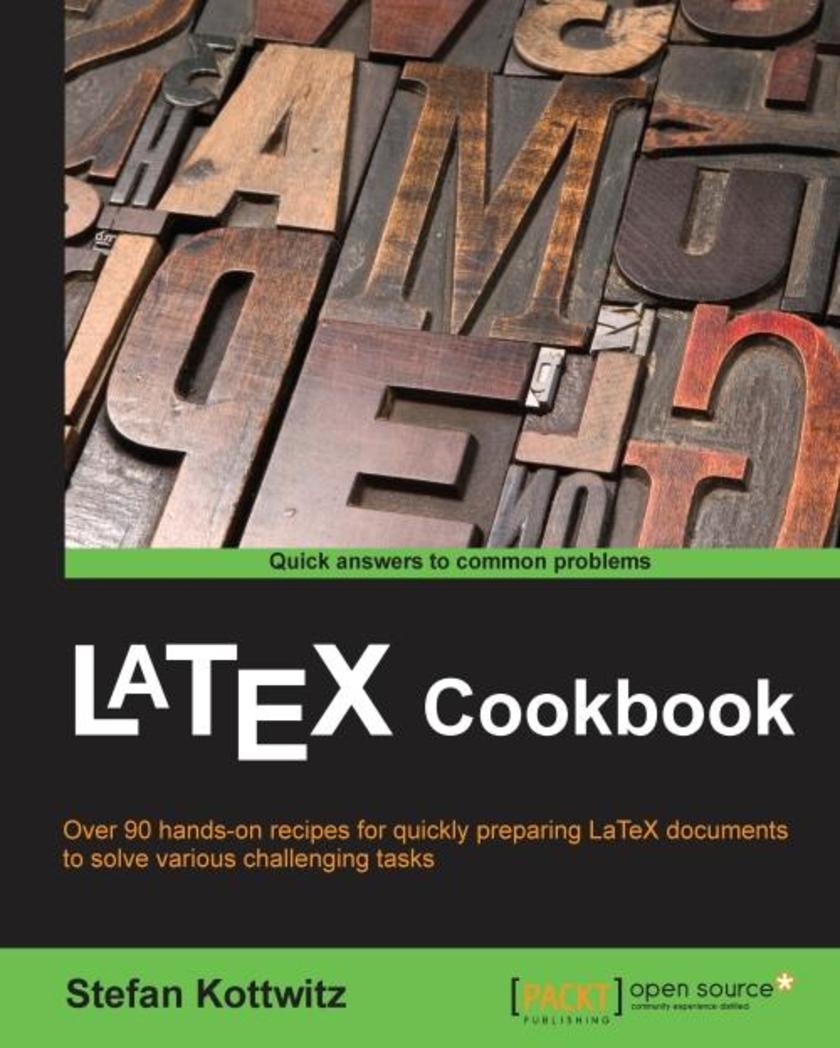
LaTeX Cookbook
¥80.65
Over 100 hands-on recipes to quickly prepare LaTeX documents of various kinds to solve challenging tasksAbout This BookWork with modern document classes, such as KOMA-Script classesExplore the latest LaTeX packages, including TikZ, pgfplots, and biblatexAn example-driven approach to creating stunning graphics directly within LaTeX Who This Book Is For If you already know the basics of LaTeX and you like to get fast, efficient solutions, this is the perfect book for you. If you are an advanced reader, you can use this book's example-driven format to take your skillset to the next level. Some familiarity with the basic syntax of LaTeX and how to use the editor of your choice for compiling is required.What You Will LearnChoose the right document class for your project to customize its featuresUtilize fonts globally and locallyFrame, shape, arrange, and annotate imagesAdd a bibliography, a glossary, and an indexCreate colorful graphics including diagrams, flow charts, bar charts, trees, plots in 2d and 3d, time lines, and mindmapsSolve typical tasks for various sciences including math, physics, chemistry, electrotechnics, and computer scienceOptimize PDF output and enrich it with meta data, annotations, popups, animations, and fill-in fieldsExplore the outstanding capabilities of the newest engines and formats such as XeLaTeX, LuaLaTeX, and LaTeX3 In Detail LaTeX is a high-quality typesetting software and is very popular, especially among scientists. Its programming language gives you full control over every aspect of your documents, no matter how complex they are. LaTeX's huge amount of customizable templates and supporting packages cover most aspects of writing with embedded typographic expertise. With this book you will learn to leverage the capabilities of the latest document classes and explore the functionalities of the newest packages. The book starts with examples of common document types. It provides you with samples for tuning text design, using fonts, embedding images, and creating legible tables. Common document parts such as the bibliography, glossary, and index are covered, with LaTeX's modern approach. You will learn how to create excellent graphics directly within LaTeX, including diagrams and plots quickly and easily. Finally, you will discover how to use the new engines XeTeX and LuaTeX for advanced programming and calculating with LaTeX. The example-driven approach of this book is sure to increase your productivity.Style and approach This book guides you through the world of LaTeX based on over a hundred hands-on examples. These are explained in detail and are designed to take minimal time and to be self-compliant.

Unreal Engine Game Development Cookbook
¥90.46
Over 40 recipes to accelerate the process of learning game design and solving development problems using Unreal EngineAbout This BookExplore the quickest way to tackle common challenges faced in Unreal EngineCreate your own content, levels, light scenes, and materials, and work with Blueprints and C++ *ingAn intermediate, fast-paced Unreal Engine guide with targeted recipes to design games within its framework Who This Book Is For This book is for those who are relatively experienced with Unreal Engine 4 and have knowledge of its fundamentals. Working knowledge of C++ is required.What You Will LearnDiscover editor functionalities for an in-depth insight into game designDevelop environments using terrain for outdoor areas and a workflow for interiors as well using brushesDesign various kinds of materials with unique features, such as mirrors and glowsExplore the various ways that lighting can be used in the engineBuild various level effects using Blueprints, Unreal's visual *ing systemSet up a development environment and develop custom functionality with C++ for your gamesCreate healthbars and main menus with animations using Slate, Unreal's UI solution, through the UMG EditorPackage and create an installer to get your project out into the world In Detail Unreal Engine is powerful tool with rich functionalities to create games. It equips you with the skills to easily build mobile and desktop games from scratch without worrying about which platform they will run on. You can focus on the individual complexities of game development such as animation and rendering. This book takes you on a journey to jumpstart your game design efforts. You will learn various aspects of the Unreal engine commonly encountered with practical examples of how it can be used, with numerous references for further study. You will start by getting acquainted with Unreal Engine 4 and building out levels for your game. This will be followed by recipes to help you create environments, place meshes, and implement your characters. You will then learn to work with lights, camera, and shadows to include special effects in your game. Moving on, you’ll learn Blueprint *ing and C++ programming to enable you to achieve trigger effects and add simple functionalities. By the end of the book, you will see how to create a healthbar and main menu, and then get your game ready to be deployed and published.Style and approach This book offers detailed, easy-to-follow recipes that will help you master a wide range of Unreal Engine 4's features. Every recipe provides step-by-step instructions, with explanations of how these features work, and alternative approaches and research materials so you can learn even more.

Scala Data Analysis Cookbook
¥80.65
Navigate the world of data analysis, visualization, and machine learning with over 100 hands-on Scala recipesAbout This BookImplement Scala in your data analysis using features from Spark, Breeze, and ZeppelinScale up your data anlytics infrastructure with practical recipes for Scala machine learningRecipes for every stage of the data analysis process, from reading and collecting data to distributed analytics Who This Book Is For This book shows data scientists and analysts how to leverage their existing knowledge of Scala for quality and scalable data analysis.What You Will LearnFamiliarize and set up the Breeze and Spark libraries and use data structuresImport data from a host of possible sources and create dataframes from CSVClean, validate and transform data using Scala to pre-process numerical and string dataIntegrate quintessential machine learning algorithms using Scala stackBundle and scale up Spark jobs by deploying them into a variety of cluster managersRun streaming and graph analytics in Spark to visualize data, enabling exploratory analysis In Detail This book will introduce you to the most popular Scala tools, libraries, and frameworks through practical recipes around loading, manipulating, and preparing your data. It will also help you explore and make sense of your data using stunning and insightfulvisualizations, and machine learning toolkits. Starting with introductory recipes on utilizing the Breeze and Spark libraries, get to grips withhow to import data from a host of possible sources and how to pre-process numerical, string, and date data. Next, you’ll get an understanding of concepts that will help you visualize data using the Apache Zeppelin and Bokeh bindings in Scala, enabling exploratory data analysis. iscover how to program quintessential machine learning algorithms using Spark ML library. Work through steps to scale your machine learning models and deploy them into a standalone cluster, EC2, YARN, and Mesos. Finally dip into the powerful options presented by Spark Streaming, and machine learning for streaming data, as well as utilizing Spark GraphX.Style and approach This book contains a rich set of recipes that covers the full spectrum of interesting data analysis tasks and will help you revolutionize your data analysis skills using Scala and Spark.
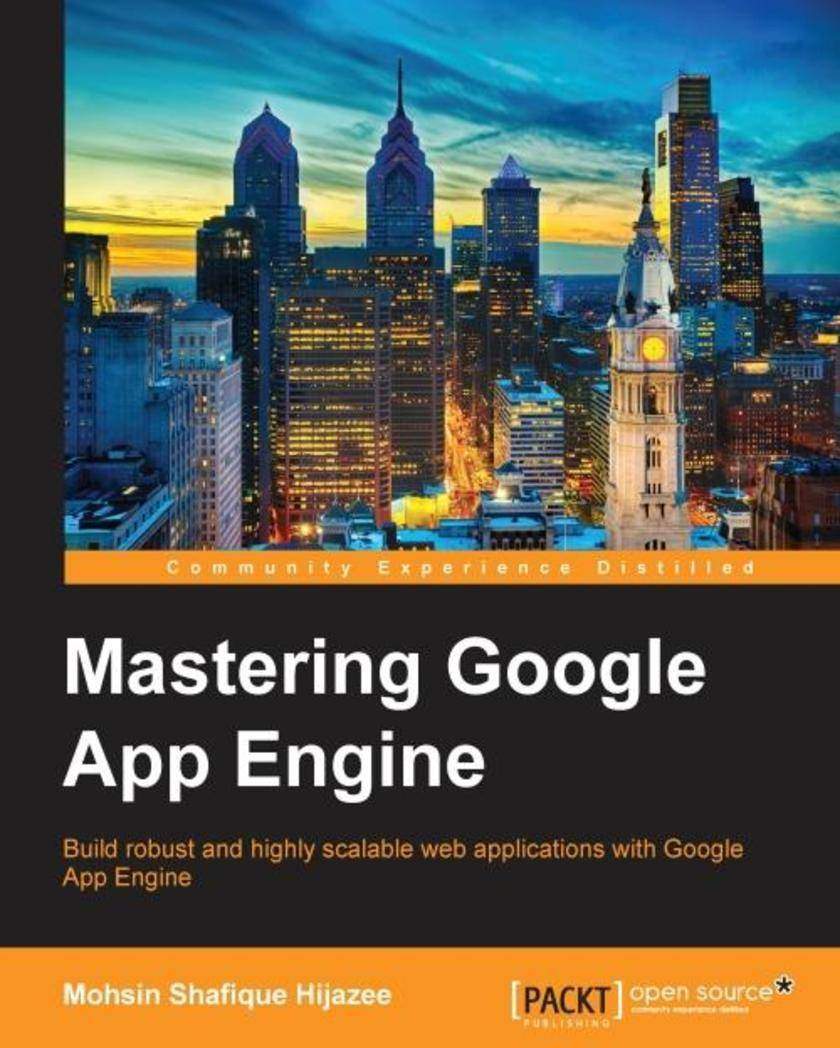
Mastering Google App Engine
¥90.46
Build robust and highly scalable web applications with Google App EngineAbout This BookGet an in-depth look at how Google App Engine works under the hoodDesign and model your application around Google's highly scalable distributed NoSQL datastore to unlock its full potentialA comprehensive guide to ensure your mastery of Google App Engine Who This Book Is For If you have been developing web applications in Python or any other dynamic language but have always wondered how to write highly scalable web applications without getting into system administration and other plumbing, then this is the book for you. No experience in writing scalable applications is required.What You Will LearnScale and develop your applications with Google App Engine's runtime environmentGet to grips with request handling mechanism and write request handlersDeep dive into Google's distributed NoSQL and highly scalable datastore and design your application around itImplement powerful search with scalable datastorePerform long-running tasks in the background using task queuesWrite compartmentalized apps using multi tenancy, memcache, and other Google App Engine runtime servicesHandle web requests using the CGI, WSGI, and multi-threaded configurationsDeploy, tweak, and manage apps in production on Google App Engine In Detail Developing web applications that serve millions of users is no easy task, as it involves a number of configurations and administrative tasks for the underlying software and hardware stack. This whole configuration requires not only expertise, but also a fair amount of time as well. Time that could have been spent on actual application functionality. Google App Engine allows you develop highly scalable web applications or backends for mobile applications without worrying about the system administration plumbing or hardware provisioning issues. Just focus writing on your business logic, the meat of the application, and let Google's powerful infrastructure scale it to thousands of requests per second and millions of users without any effort on your part. This book takes you from explaining how scalable applications work to designing and developing robust scalable web applications of your own, utilizing services available on Google App Engine. Starting with a walkthrough of scalability is and how scalable web applications work, this book introduces you to the environment under which your applications exist on Google App Engine. Next, you will learn about Google's datastore, which is a massively scalable distributed NoSQL solution built on top of BigTable. You will examine the BigTable concepts and operations in detail and reveal how it is used to build Google datastore. Armed with this knowledge, you will then advance towards how to best model your data and query that along with transactions. To augment the powerful distributed dataset, you will deep dive into search functionality offered on Google App Engine. With the search and storage sorted out, you will get a look into performing long running tasks in the background using Google App Engine task queues along with sending and receiving emails. You will also examine the memcache to boost web application performance, image processing for common image manipulation tasks. You will then explore uploading, storing, and serving large files using Blobstore and Cloud storage. Finally, you will be presented with the deployment and monitoring of your applications in production along with a detailed look at dividing applications into different working modules.Style and approach This book is an in-depth guide where you will examine the problems in the context of highly scalable web applications. This book will take you through the libraries, services, and required configuration and finally puts everything together into a small web application that showcases all the capabilities of Google App Engine.

Mastering Jenkins
¥90.46
Configure and extend Jenkins to architect, build, and automate efficient software delivery pipelinesAbout This BookConfigure and horizontally scale a Jenkins installation to support a development organization of any sizeImplement Continuous Integration, Continuous Delivery, and Continuous Deployment solutions in JenkinsA step-by-step guide to help you get the most out of the powerful automation orchestration platform that is Jenkins Who This Book Is For If you are a novice or intermediate-level Jenkins user who has used Jenkins before but are not familiar with architecting solutions and implementing it in your organization, then this is the book for you. A basic understanding of the core elements of Jenkins is required to make the best use of this book.What You Will LearnCreate and manage various types of build jobs, and implement automation tasks to support a software project of any kindGet to grips with the automated testing architecture, and scalable automated testing techniquesFacilitate the delivery of software across the SDLC by creating scalable automated deployment solutionsManage scalable automation pipelines in Jenkins using the latest build, test, and deployment strategiesImplement a scalable master / slave build automation platform, which can support Windows, Mac OSX, and Linux software solutionsCover troubleshooting and advanced configuration techniques for Jenkins slave nodesSupport a robust build and delivery system by implementing basic infrastructure as code solutions in configuration management tools such as Ansible In Detail With the software industry becoming more and more competitive, organizations are now integrating delivery automation and automated quality assurance practices into their business model. Jenkins represents a complete automation orchestration system, and can help converge once segregated groups into a cohesive product development and delivery team. By mastering the Jenkins platform and learning to architect and implement Continuous Integration, Continuous Delivery, and Continuous Deployment solutions, your organization can learn to outmanoeuvre and outpace the competition. This book will equip you with the best practices to implement advanced continuous delivery and deployment systems in Jenkins. The book begins with giving you high-level architectural fundamentals surrounding Jenkins and Continuous Integration. You will cover the different installation scenarios for Jenkins, and see how to install it as a service, as well as the advanced XML configurations. Then, you will proceed to learn more about the architecture and implementation of the Jenkins Master/Save node system, followed by creating and managing Jenkins build jobs effectively. Furthermore, you’ll explore Jenkins as an automation orchestration system, followed by implementing advanced automated testing techniques. The final chapters describe in depth the common integrations to Jenkins from third-party tools such as Jira, Artifactory, Amazon EC2, and getting the most out of the Jenkins REST-based API. By the end of this book, you will have all the knowledge necessary to be the definitive resource for managing and implementing advanced Jenkins automation solutions for your organization.Style and approach This book is a step-by-step guide to architecting and implementing automated build solutions, automated testing practices, and automated delivery methodologies. The topics covered are based on industry-proven techniques, and are explained in a simple and easy to understand manner.
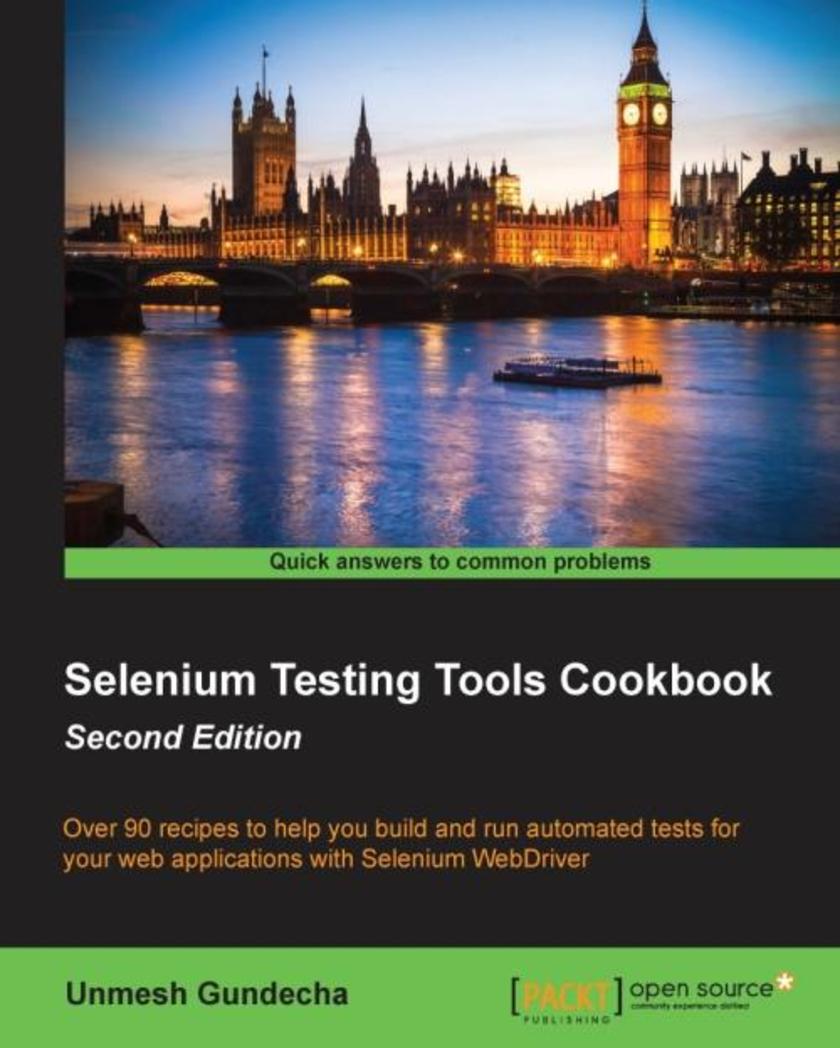
Selenium Testing Tools Cookbook - Second Edition
¥80.65
Over 90 recipes to help you build and run automated tests for your web applications with Selenium WebDriverAbout This BookLearn to leverage the power of Selenium WebDriver with simple examples that illustrate real-world problems and their workaroundsExplains the testing of mobile applications with Appium for mobile platforms such as iOS and AndroidA pragmatic manual with engaging recipes and attractive screenshots to test your web applications efficiently Who This Book Is For This book is intended for software quality assurance/testing professionals, software project managers, or software developers with prior experience in using Selenium and Java to test web-based applications. This books also provides examples for C#, Python and Ruby users.What You Will LearnUnderstand how the locators work and use various locator methods to build reliable testsBuild reliable and maintainable tests with the Selenium WebDriver APIUse the PageFactory pattern to build a robust and easy to maintain test frameworkBuild data-driven tests and extend Selenium API to implement custom steps and checksIntegrate and use ATDD/BDD tools such as Cucumber, SpecFlow, Capybara, and Behave with the Selenium WebDriver APISet up iPhone/iPad and Android simulators and devices to test your mobile web application with AppiumSet up Selenium Grid for faster and parallel running of tests, increasing test coverage and reducing test execution time for cross-browser testingBuild extended Selenium WebDriver tests for additional coverage In Detail This book is an incremental guide that will help you learn and use the advanced features of the Selenium toolset including the WebDriver API in various situations to build a reliable test automation. You start off by setting up the test development environment and gain tips on the advanced locater strategy and the effective use of the Selenium WebDriver API. After that, the use of design patterns such as data - driven tests and PageFactory are demonstrated. You will then be familiarised with extending Selenium WebDriver API by implementing custom tasks and setting up your own distributed environment to run tests in parallel for cross-browser testing. Finally, we give you some tips on integrating Selenium WebDriver with other popular tools and testing mobile applications. By the end of this book, you will have learned enough to solve complex testing issues on your own.Style and approach This recipe-based guide covers real-life scenarios of testing your web apps with Selenium. Each recipe begins with a short introduction and key concepts along with illustrated examples of use cases, and ends with detailed but informative de*ions of the inner workings of the example.
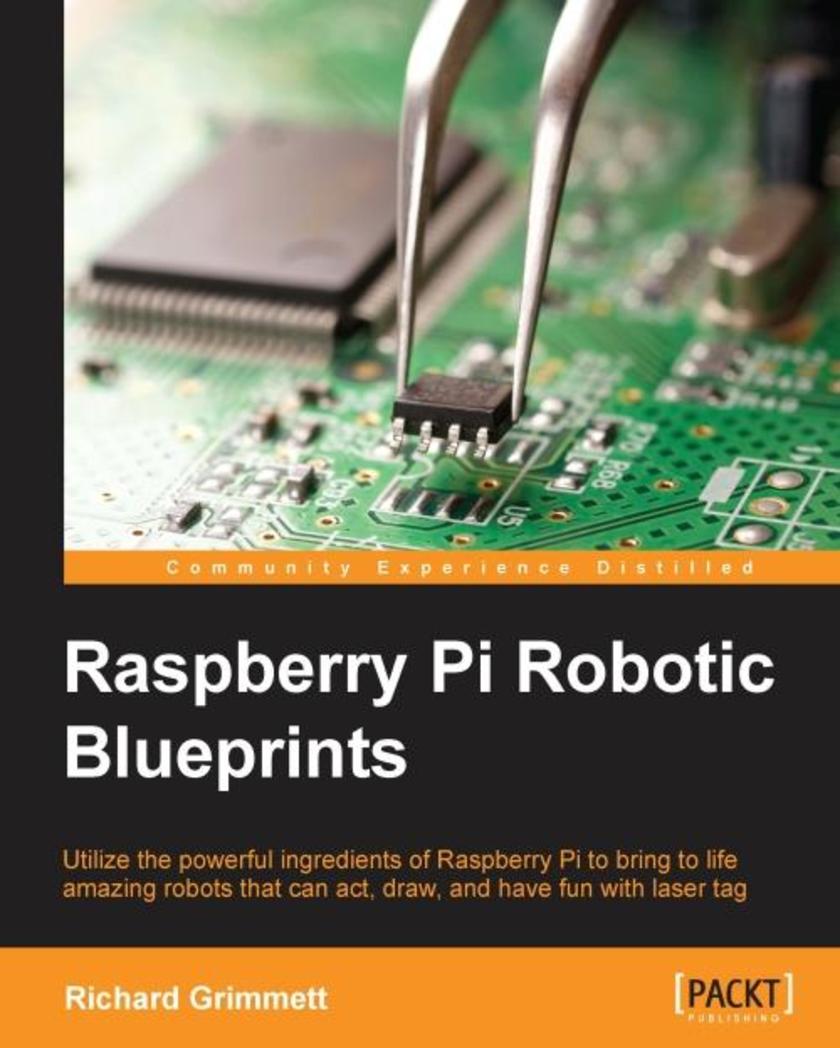
Raspberry Pi Robotic Blueprints
¥80.65
Utilize the powerful ingredients of Raspberry Pi to bring to life your amazing robots that can act, draw, and have fun with laser tagsAbout This BookLearn to implement a number of features offered by Raspberry Pi to build your own amazing robotsUnderstand how to add vision and voice to your robots.This fast-paced practical guide comprises a number of creative projects to take your Raspberry Pi knowledge to the next level Who This Book Is For This all-encompassing guide was created for anyone who is interested in expanding their knowledge in applying the peripherals of Raspberry Pi. If you have a fancy for building complex-looking robots with simple, inexpensive, and readily available hardware, then this book is ideal for you. Prior understanding of Raspberry Pi with simple mechanical systems is recommended.What You Will LearnAdd sensors to your robot so that it can sense the world around itKnow everything there is to know about accessing motors and servos to provide movement to the robotic platformExplore the feature of adding vision to your robot so it can “see” the world around itRefine your robot with the skill of speech recognition so that it can receive commandsPolish your robot by adding speech output so it can communicate with the world around itMaximize the use of servos in Raspberry Pi to create a drawing robotStrengthen your robot by adding wireless communication skills so you can see what the robot is seeing and control it from a distanceBuild an unbelievable autonomous hexcopter controlled by Raspberry Pi In Detail The Raspberry Pi is a series of credit card-sized single-board computers developed in the UK by the Raspberry Pi Foundation with the intention of promoting the teaching of basic computer science in schools. The Raspberry Pi is known as a tiny computer built on a single circuit board. It runs a Linux operating system, and has connection ports for various peripherals so that it can be hooked up to sensors, motors, cameras, and more. Raspberry Pi has been hugely popular among hardware hobbyists for various projects, including robotics. This book gives you an insight into implementing several creative projects using the peripherals provided by Raspberry Pi. To start, we’ll walk through the basic robotics concepts that the world of Raspberry Pi offers us, implementing wireless communication to control your robot from a distance. Next, we demonstrate how to build a sensible and a visionary robot, maximizing the use of sensors and step controllers. After that, we focus on building a wheeled robot that can draw and play hockey. To finish with a bang, we’ll build an autonomous hexcopter, that is, a flying robot controlled by Raspberry Pi. By the end of this book, you will be a maestro in applying an array of different technologies to create almost any imaginable robot.Style and approach This book is an easy-to-follow, project-based guide that throws you directly into the action of creating almost any imaginable robot through blueprints. It is full of step by step instructions and screenshots to help you build amazing robots in no time at all.
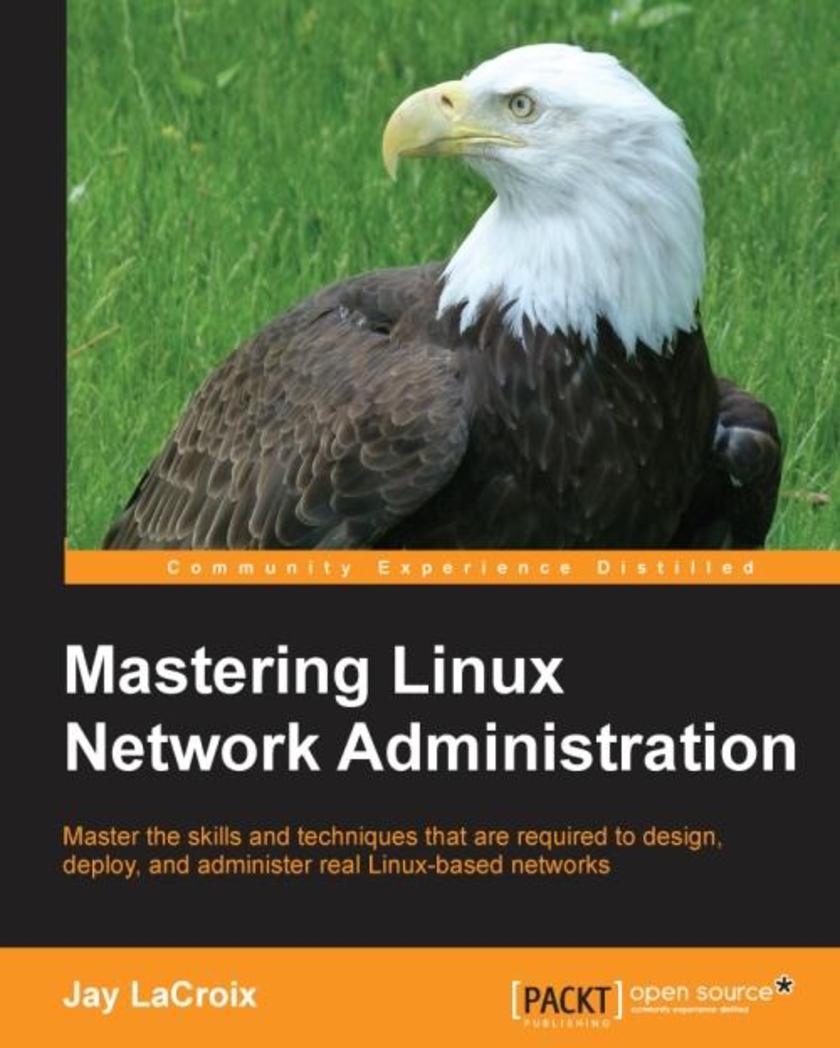
Mastering Linux Network Administration
¥90.46
Master the skills and techniques that are required to design, deploy, and administer real Linux-based networksAbout This BookMaster the art of using Linux and administering network services for enterprise environmentsPerform hands-on activities to reinforce expert-level knowledgeGet full coverage of both the CentOS and Debian systems, including how networking concepts differ for each Who This Book Is For Mastering Linux Network Administration is recommended for those who already understand the basics of using Linux and networking, and would like to push those skills to a higher level through real-world Linux networking scenarios. Whether you intend to run a home office consisting of Linux nodes or a rollout of a Linux network within your organization, this book is a great fit for those that desire to learn how to manage networked systems with the power of Linux.What You Will LearnInstall and configure the Debian and CentOS systemsSet up and configure file serversAdminister networked nodes remotelyDiscover how to monitor system performance for peak healthConfigure network services such as DNS and DHCPHost HTTP content via ApacheTroubleshoot Linux networking issues In Detail Linux is everywhere. Whether you run a home office, a small business, or manage enterprise systems, Linux can empower your network to perform at its very best. Armed with the advanced tools and best practice guidance of this practical guide, you'll be able to mold Linux networks to your will, empowering your systems and their users to take advantage of all that Linux-based networks have to offer. Understand how Linux networks function and get to grips with essential tips and tricks to manage them - whether you're already managing a networks, or even just starting out. With Debian and CentOS as its source, this book will divulge all the details you need to manage a real Linux-based network. With detailed activities and instructions based on real-world scenarios, this book will be your guide to the exciting world of Linux networking.Style and approach This practical guide will walk you through all the core concepts required to manage real Linux-based networks.
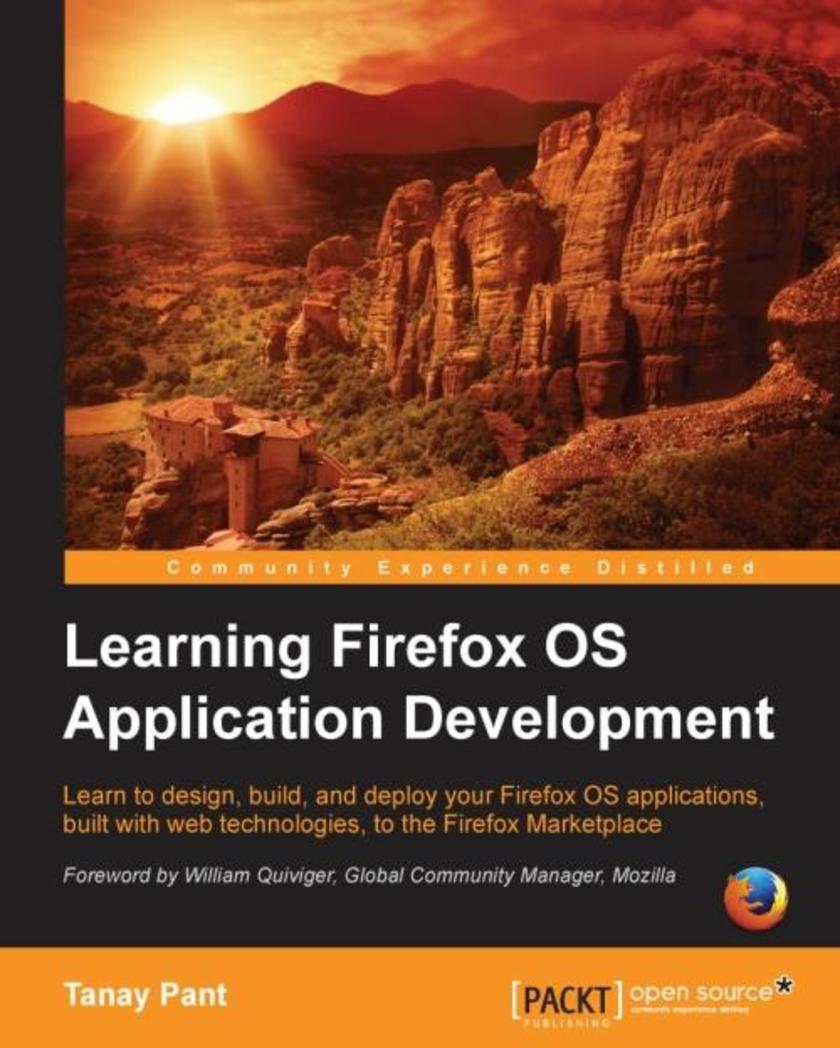
Learning Firefox OS Application Development
¥54.49
Learn to design, build, and deploy your Firefox OS applications, built with web technologies, to the Firefox MarketplaceAbout This BookCreate beautiful and interactive Firefox OS applications by applying your knowledge of web developmentCater your applications to a huge number of users by porting them to the Firefox OSA step-by-step learning workflow with real-life applications to demonstrate the concepts Who This Book Is For This is a practical guide that uses hands-on examples to teach you how to create applications for Firefox OS and also how to port applications to Firefox Marketplace. This book is intended for developers who want to build applications for Firefox OS. An understanding of HTML5, JavaScript, and CSS is required.What You Will LearnInstall, use, and access the Firefox OS simulator with the help of WebIDEGet to know about application manifest files and the essential difference between web applications and Firefox OS applicationsCreate an application that measures the tapping speed of the userCreate an application that allows a user to check in at a place with geolocation taggingAccess device-specific features with WebAPIs and implement these by building a photo editing and sharing applicationSubmit your own applications to the Firefox Marketplace and share them with othersProfessionally maintain the code of your application with the help of Github and deploy your hosted applications to OpenShift In Detail With broad compatibility, the latest in web technologies, and powerful development tools, Firefox is a great choice for both web developers and end users. Firefox OS’s promotion of HTML5 as a first class citizen opens up the walled gardens of mobile application development for web developers. It is because of this initiative that no special SDKs are required to develop for Firefox OS. This book will help you excel in the art of developing applications for Firefox OS. It sequentially covers knowledge building, skills acquisition, and practical applications. Starting with an introduction to Firefox OS, usage of WebIDE, and then the application structure, this book introduces applications of increasing complexity with each chapter. An application that measures your tapping speed, a geolocation tagging application, and a photo editing and sharing application are the three applications that will be built from scratch. You will learn about topics such as the difference between various types of Firefox OS applications, application manifest files, offline apps, and designing principles for applications. You will also learn to test and submit the applications to the marketplace and finally maintain the repository of the Firefox OS application. By the end, you will be able to develop beautifully designed, fully-fledged, and rigorously tested Firefox OS applications and also share them at the Firefox OS Marketplace.Style and approach This book is an easy-to-grasp workflow with practical examples of real-world applications such as Clickr, Check In!, and FotoFox. Each chapter explains the concepts, which are then reinforced as they are demonstrated in an application or a flowchart.

PrimeFaces Theme Development
¥63.21
Create, package, and customize stunning themes using PrimeFacesAbout This BookBuild PrimeFaces themes that meet the industry standardsCustomize your themes for mobile web applications with PrimeFaces MobileA precise, example-oriented guide to help you create interesting themes using the PrimeFaces tools Who This Book Is For If you are a Web Designer who wants to create and modify PrimeFaces themes then this book is for you. Basic knowledge of JSF, CSS, and HTML is assumed.What You Will LearnUse Maven to create JSF ProjectsCreate a custom theme using JQuery UI toolsPackage your theme for distribution and use your PrimeFaces-based web applications as drop in librariesDevelop additional dynamic look and feel elements that themes do not already supplyApply look and feel elements dynamically to views without causing page refreshesReduce code repetition by applying page templates to your JSF project In Detail Developing stunning themes for web applications has never been easier! PrimeFaces delivers a powerful set of features that enables JSF developers to create and customize awesome themes on the web. It is very easy to use because it comes as a single JAR file and requires no mandatory XML configuration. With more than 30 out-of-the-box themes, jQuery integration, a mobile UI toolkit, Ajax Push technology, and much more, PrimeFaces takes JSF application development to a whole new level! This book is a hands-on example-rich guide to creating and customizing PrimeFaces themes using available tools. Beginning with creating a JSF project and integrating the PrimeFaces library, this book will introduce you to the features of theme components, how these are structured, and how PrimeFaces uses JQuery UI to apply a theme to your application. You will learn to examine and change the CSS rules and get creative by setting standard icons and adding new icons to them. You will use a combination of JavaScript and CSS to enhance your application with help of scheduler component and go on to adapt and package your custom theme so that it is compatible with the Resource Manager. Finally, you will explore PrimeFaces mobile apps, ensuring themes are compatible with your mobile applications best practices for theme design.Style and approach This book is a concise, hands-on guide to developing PrimeFaces themes, working from the ground up with examples in each topic implemented in a web application. You will be encouraged to explore areas of your own interest without the requirement to stick to the letter of the chapter.
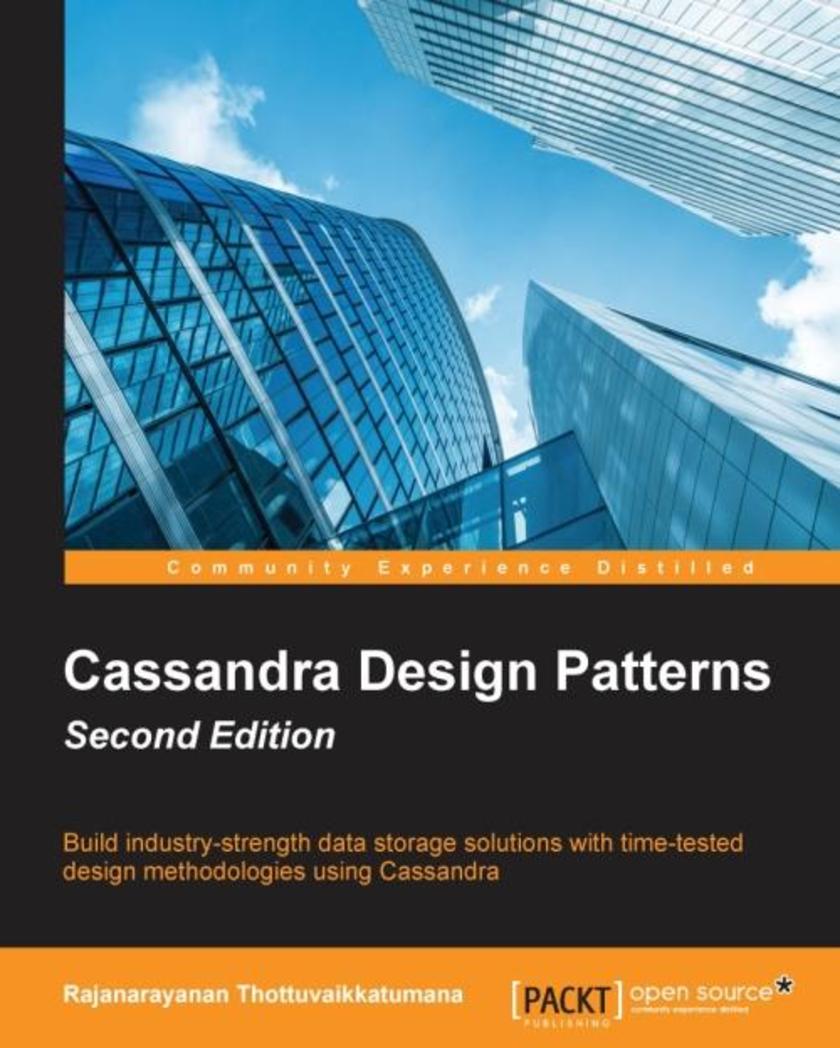
Cassandra Design Patterns - Second Edition
¥63.21
Build real-world, industry-strength data storage solutions with time-tested design methodologies using CassandraAbout This BookExplore design patterns which co-exist with legacy data stores, migration from RDBMS, and caching technologies with CassandraLearn about design patterns and use Cassandra to provide consistency, availability, and partition tolerance guarantees for applicationsHandle temporal data for analytical purposes Who This Book Is For This book is intended for big data developers who are familiar with the basics of Cassandra and wish to understand and utilize Cassandra design patterns to develop real-world big data solutions. Prior knowledge of RDBMS solutions is assumed.What You Will LearnEnable Cassandra to co-exist with RDBMS and other legacy data storesExplore various design patterns to build effective and robust storage solutionsMigrate from RDBMS-based data stores and caching solutions to CassandraUnderstand the behaviour of Cassandra when trying to balance the needs of consistency, availability, and partition toleranceDeal with time stamps related to data effectivelySee how Cassandra can be used in analytical use casesApply the design patterns covered in this book in real-world use cases In Detail There are many NoSQL data stores used by big data applications. Cassandra is one of the most widely used NoSQL data stores that is frequently used by a huge number of heavy duty Internet-scale applications. Unlike the RDBMS world, the NoSQL landscape is very diverse and there is no one way to model data stores. This mandates the need to have good solutions to commonly seen data store design problems. Cassandra addresses such common problems simply. If you are new to Cassandra but well-versed in RDBMS modeling and design, then it is natural to model data in the same way in Cassandra, resulting in poorly performing applications and losing the real purpose of Cassandra. If you want to learn to make the most of Cassandra, this book is for you. This book starts with strategies to integrate Cassandra with other legacy data stores and progresses to the ways in which a migration from RDBMS to Cassandra can be accomplished. The journey continues with ideas to migrate data from cache solutions to Cassandra. With this, the stage is set and the book moves on to some of the most commonly seen problems in applications when dealing with consistency, availability, and partition tolerance guarantees. Cassandra is exceptionally good at dealing with temporal data and patterns such as the time-series pattern and log pattern, which are covered next. Many NoSQL data stores fail miserably when a huge amount of data is read for analytical purposes, but Cassandra is different in this regard. Keeping analytical needs in mind, you’ll walk through different and interesting design patterns. No theoretical discussions are complete without a good set of use cases to which the knowledge gained can be applied, so the book concludes with a set of use cases you can apply the patterns you’ve learned.Style and approach This book is written in very simple language and an engaging style complete with examples in every chapter and real-world use cases at the end of the book.
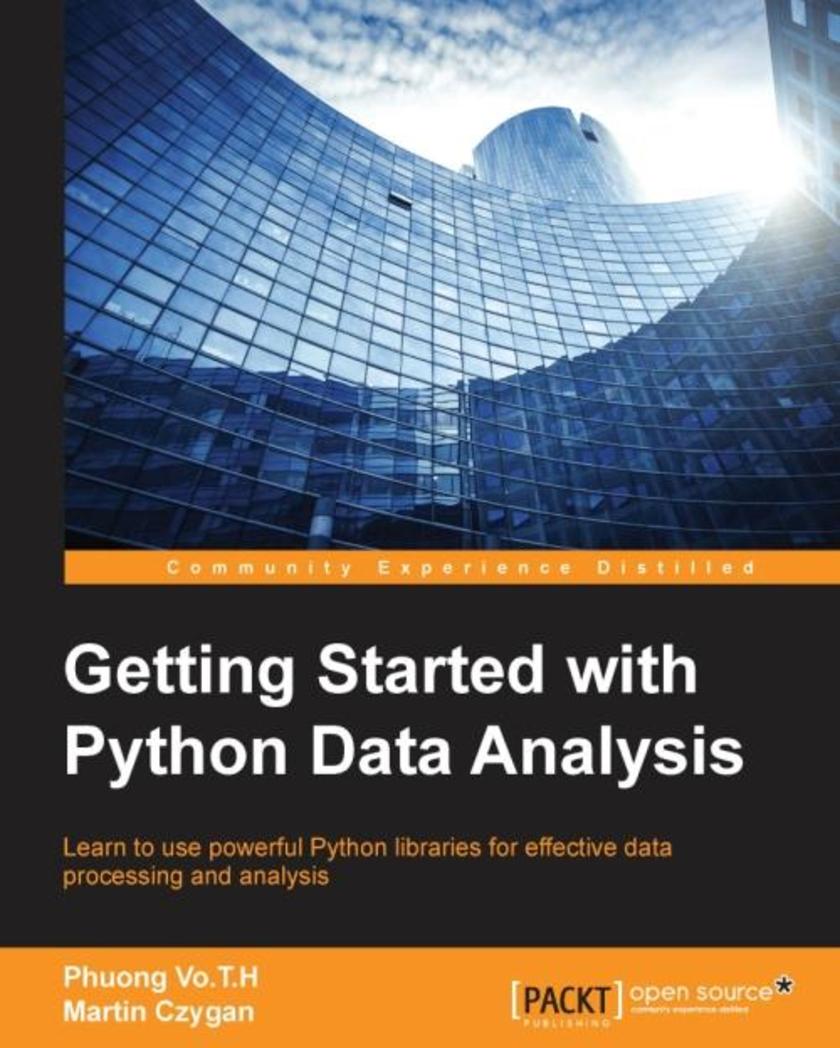
Getting Started with Python Data Analysis
¥63.21
Learn to use powerful Python libraries for effective data processing and analysisAbout This BookLearn the basic processing steps in data analysis and how to use Python in this area through supported packages, especially Numpy, Pandas, and MatplotlibCreate, manipulate, and analyze your data to extract useful information to optimize your systemA hands-on guide to help you learn data analysis using Python Who This Book Is For If you are a Python developer who wants to get started with data analysis and you need a quick introductory guide to the python data analysis libraries, then this book is for you.What You Will LearnUnderstand the importance of data analysis and get familiar with its processing stepsGet acquainted with Numpy to use with arrays and array-oriented computing in data analysisCreate effective visualizations to present your data using MatplotlibProcess and analyze data using the time series capabilities of PandasInteract with different kind of database systems, such as file, disk format, Mongo, and RedisApply the supported Python package to data analysis applications through examplesExplore predictive analytics and machine learning algorithms using Scikit-learn, a Python library In Detail Data analysis is the process of applying logical and analytical reasoning to study each component of data. Python is a multi-domain, high-level, programming language. It’s often used as a *ing language because of its forgiving syntax and operability with a wide variety of different eco-systems. Python has powerful standard libraries or toolkits such as Pylearn2 and Hebel, which offers a fast, reliable, cross-platform environment for data analysis. With this book, we will get you started with Python data analysis and show you what its advantages are. The book starts by introducing the principles of data analysis and supported libraries, along with NumPy basics for statistic and data processing. Next it provides an overview of the Pandas package and uses its powerful features to solve data processing problems. Moving on, the book takes you through a brief overview of the Matplotlib API and some common plotting functions for DataFrame such as plot. Next, it will teach you to manipulate the time and data structure, and load and store data in a file or database using Python packages. The book will also teach you how to apply powerful packages in Python to process raw data into pure and helpful data using examples. Finally, the book gives you a brief overview of machine learning algorithms, that is, applying data analysis results to make decisions or build helpful products, such as recommendations and predictions using scikit-learn.Style and approach This is an easy-to-follow, step-by-step guide to get you familiar with data analysis and the libraries supported by Python. Topics are explained with real-world examples wherever required.
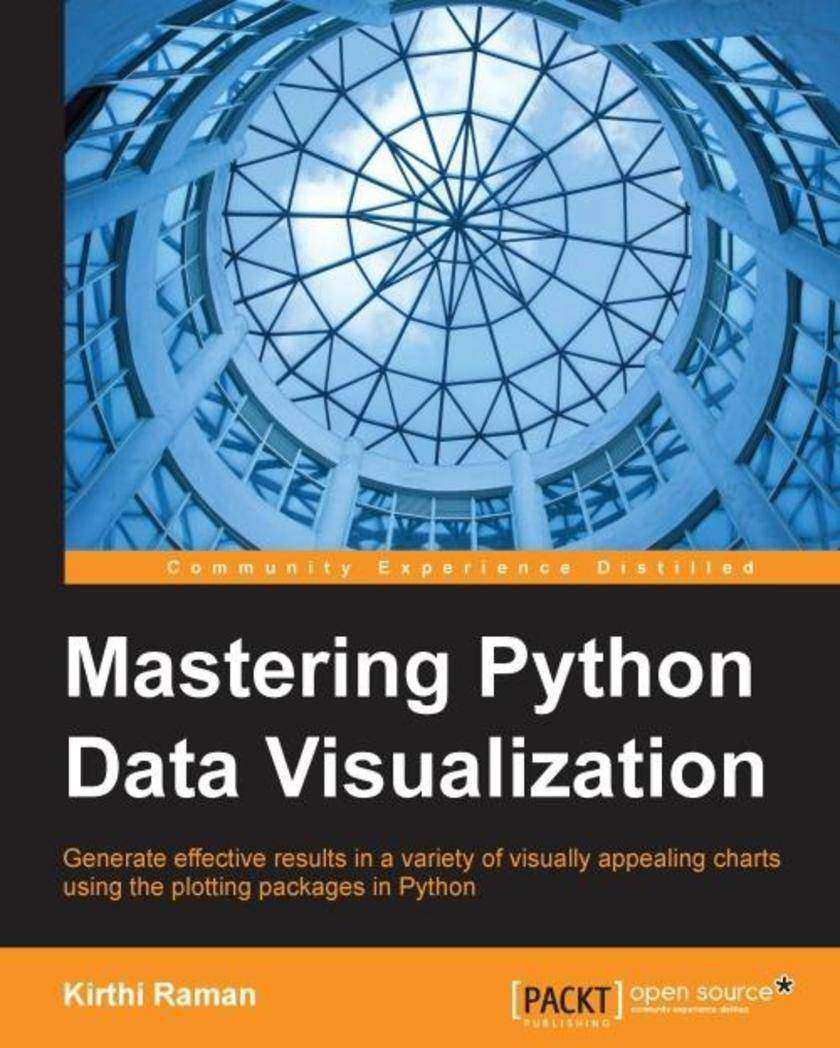
Mastering Python Data Visualization
¥99.18
Generate effective results in a variety of visually appealing charts using the plotting packages in PythonAbout This BookExplore various tools and their strengths while building meaningful representations that can make it easier to understand dataPacked with computational methods and algorithms in diverse fields of scienceWritten in an easy-to-follow categorical style, this book discusses some niche techniques that will make your code easier to work with and reuse Who This Book Is For If you are a Python developer who performs data visualization and wants to develop existing knowledge about Python to build analytical results and produce some amazing visual display, then this book is for you. A basic knowledge level and understanding of Python libraries is assumed.What You Will LearnGather, cleanse, access, and map data to a visual frameworkRecognize which visualization method is applicable and learn best practices for data visualizationGet acquainted with reader-driven narratives and author-driven narratives and the principles of perceptionUnderstand why Python is an effective tool to be used for numerical computation much like MATLAB, and explore some interesting data structures that come with itExplore with various visualization choices how Python can be very useful in computation in the field of finance and statisticsGet to know why Python is the second choice after Java, and is used frequently in the field of machine learningCompare Python with other visualization approaches using Julia and a JavaScript-based framework such as D3.jsDiscover how Python can be used in conjunction with NoSQL such as Hive to produce results efficiently in a distributed environment In Detail Python has a handful of open source libraries for numerical computations involving optimization, linear algebra, integration, interpolation, and other special functions using array objects, machine learning, data mining, and plotting. Pandas have a productive environment for data analysis. These libraries have a specific purpose and play an important role in the research into diverse domains including economics, finance, biological sciences, social science, health care, and many more. The variety of tools and approaches available within Python community is stunning, and can bolster and enhance visual story experiences. This book offers practical guidance to help you on the journey to effective data visualization. Commencing with a chapter on the data framework, which explains the transformation of data into information and eventually knowledge, this book subsequently covers the complete visualization process using the most popular Python libraries with working examples. You will learn the usage of Numpy, Scipy, IPython, MatPlotLib, Pandas, Patsy, and Scikit-Learn with a focus on generating results that can be visualized in many different ways. Further chapters are aimed at not only showing advanced techniques such as interactive plotting; numerical, graphical linear, and non-linear regression; clustering and classification, but also in helping you understand the aesthetics and best practices of data visualization. The book concludes with interesting examples such as social networks, directed graph examples in real-life, data structures appropriate for these problems, and network analysis. By the end of this book, you will be able to effectively solve a broad set of data analysis problems.Style and approach The approach of this book is not step by step, but rather categorical. The categories are based on fields such as bioinformatics, statistical and machine learning, financial computation, and linear algebra. This approach is beneficial for the community in many different fields of work and also helps you learn how one approach can make sense across many fields
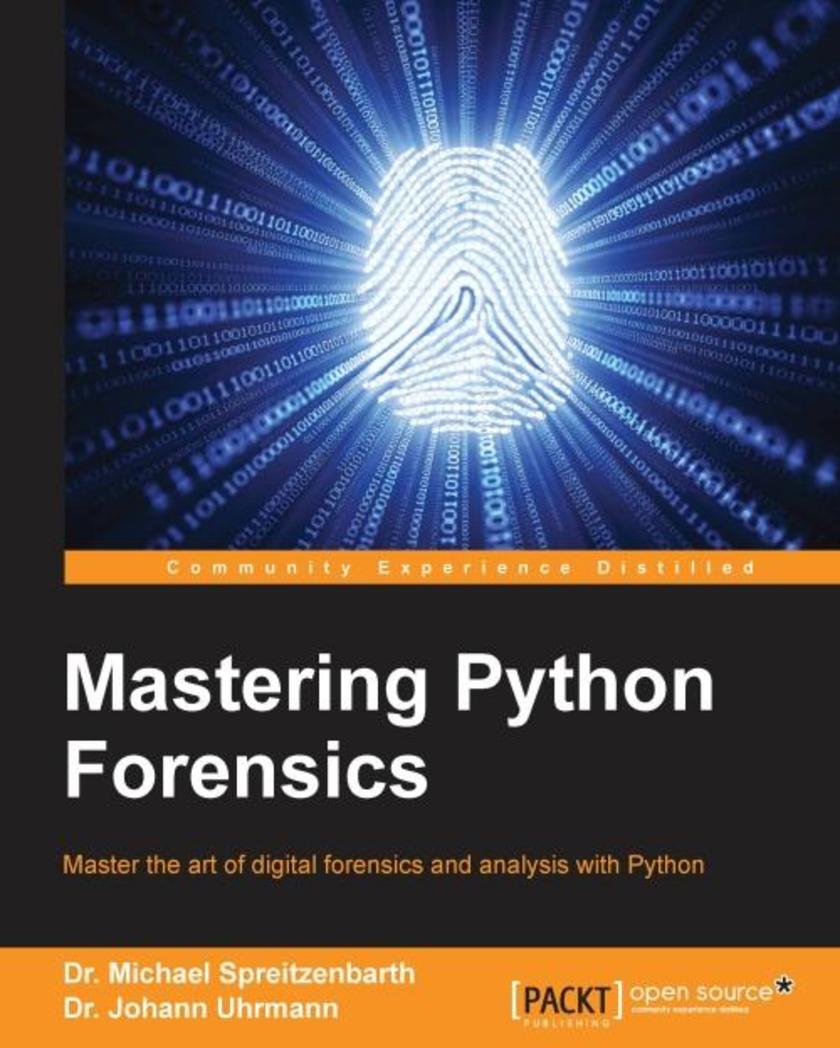
Mastering Python Forensics
¥71.93
Master the art of digital forensics and analysis with PythonAbout This BookLearn to perform forensic analysis and investigations with the help of Python, and gain an advanced understanding of the various Python libraries and frameworksAnalyze Python *s to extract metadata and investigate forensic artifactsThe writers, Dr. Michael Spreitzenbarth and Dr. Johann Uhrmann, have used their experience to craft this hands-on guide to using Python for forensic analysis and investigations Who This Book Is For If you are a network security professional or forensics analyst who wants to gain a deeper understanding of performing forensic analysis with Python, then this book is for you. Some Python experience would be helpful.What You Will LearnExplore the forensic analysis of different platforms such as Windows, Android, and vSphereSemi-automatically reconstruct major parts of the system activity and time-lineLeverage Python ctypes for protocol decodingExamine artifacts from mobile, Skype, and browsersDiscover how to utilize Python to improve the focus of your analysisInvestigate in volatile memory with the help of volatility on the Android and Linux platforms In Detail Digital forensic analysis is the process of examining and extracting data digitally and examining it. Python has the combination of power, expressiveness, and ease of use that makes it an essential complementary tool to the traditional, off-the-shelf digital forensic tools. This book will teach you how to perform forensic analysis and investigations by exploring the capabilities of various Python libraries. The book starts by explaining the building blocks of the Python programming language, especially ctypes in-depth, along with how to automate typical tasks in file system analysis, common correlation tasks to discover anomalies, as well as templates for investigations. Next, we’ll show you cryptographic algorithms that can be used during forensic investigations to check for known files or to compare suspicious files with online services such as VirusTotal or Mobile-Sandbox. Moving on, you’ll learn how to sniff on the network, generate and analyze network flows, and perform log correlation with the help of Python *s and tools. You’ll get to know about the concepts of virtualization and how virtualization influences IT forensics, and you’ll discover how to perform forensic analysis of a jailbroken/rooted mobile device that is based on iOS or Android. Finally, the book teaches you how to analyze volatile memory and search for known malware samples based on YARA rules.Style and approach This easy-to-follow guide will demonstrate forensic analysis techniques by showing you how to solve real-word-scenarios step by step.
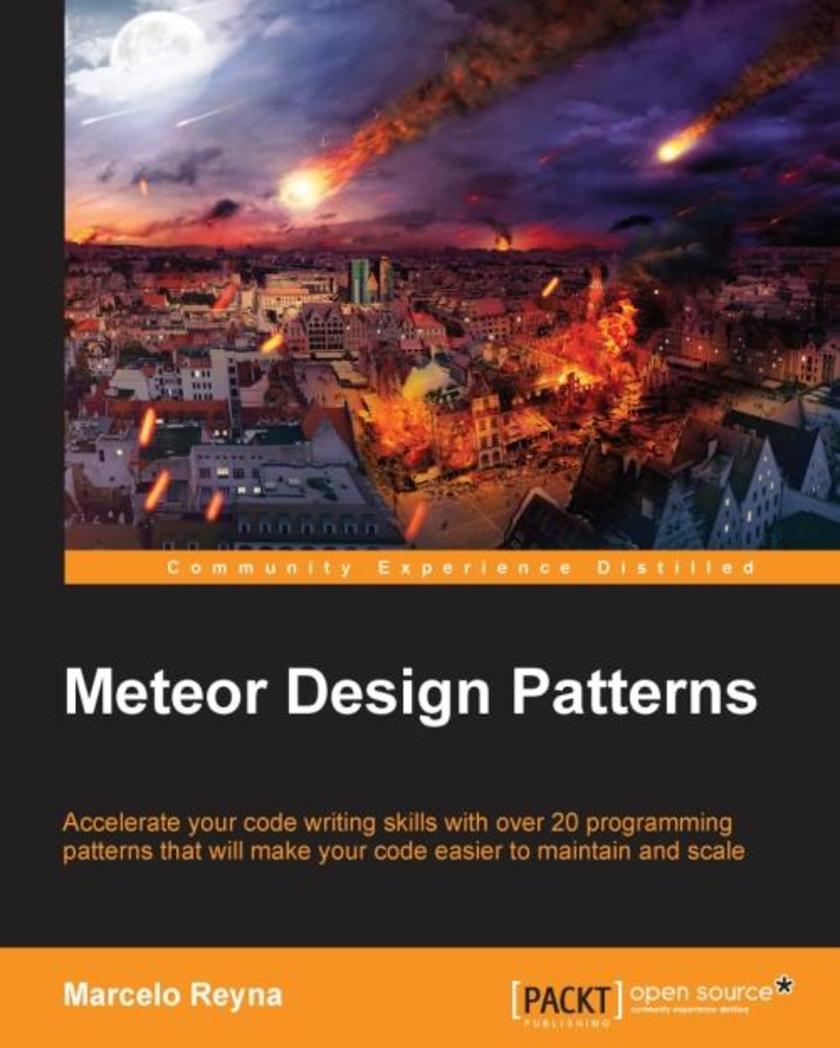
Meteor Design Patterns
¥63.21
Accelerate your code writing skills with over twenty programming patterns that will make your code easier to maintain and scaleAbout This BookOptimize your web application for production useBuild views and controllers with minimal effort that will evolve with your applicationLearn how to maintain a MeteorJS project while it is running in production Who This Book Is For This book is for developers who have already had an introductory course with Meteor. Basic knowledge of web development is recommended.What You Will LearnUse of Jade, Stylus, and CoffeeScript to speed up web developmentIncrease productivity by leveraging the best packages in the communityOptimize your site for load speed with advanced publishers and subscribersLeverage the aggregation framework to produce results with big dataMaster the intricacies of front-end development using Jeet, Bootstrap, CSS animations, and moreOptimize your site for search engine visibilitySecure your site with Meteor’s best practicesTrack the live status of your application, ensuring all errors have been taken care of In Detail With the increasing interest in NodeJS web applications, a new framework, Meteor, has joined the ranks to simplify developer workflows. Meteor is one of the few open source frameworks that has received funding since its early development stages. It builds on ideas from existing frameworks and libraries, offering developers an easy way to develop a prototype app. At the same time, it gives them the tools and flexibility to build a fully fledged production app. Meteor is the weapon of choice for start-ups in today’s world. Meteor Design Patterns cuts through the jargon that most websites play with and gets to the point with simple solutions that will boost your development skills. We start off with a refresher on the basics of JavaScript programming such as templates, CoffeeScript, the Event Loop, and the Merge Box, amongst others. You then learn how to map real-world data and optimize the data’s publishers to output data with the least amount of work done by the server with some subscribe and publish patterns. Next, using front-end patterns, you will learn how to create maintainable and trackable forms, and make our site crawlable by any search engine. Following this, you will see how to optimize and secure the web application and maintain applications without breaking other features. Finally, you will learn how to deploy a secure production-ready application while learning to set up modulus, compose with Oplog tracking and SSL certificates, as well as error tracking with Kadira. Throughout the book, you will put your skills to practice and build an online shop from scratch. By the end of the book, you will have built a feature-rich online shop.Style and approach The book is a practical handbook on how to build an e-commerce web app using Meteor. Every topic ties into the webapp to easily illustrate the concepts that you are learning about.




 购物车
购物车 个人中心
个人中心



